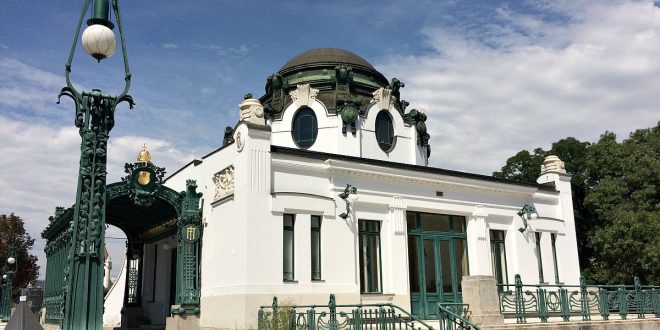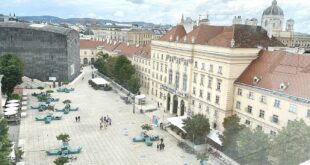Otto Wagner Vienna. Unlike any other, Austrian architect, furniture designer, and interior decorator Otto Wagner holds the key to Viennese Modernist and Art Nouveau architecture. Essentially, Wagner catapulted Fin-de-Siècle Vienna into the 20th century by celebrating the beauty of simplicity. If you want to trace this period when in Wien, use these eight signature pieces below to plan your itinerary.
Otto Wagner in Vienna: His Main Works
Otto Wagner Vienna. Most notably, Otto Wagner (1841 to 1918) was one of the founding members of the revolutionary artists’ association Vienna Secession. In the last 20 years of his life the trained architect, visual artist and brick layer shaped Vienna with a series of constructions. Among the best are the Austrian Postal Savings Bank, villas, railway stations, and residential buildings to the most beautiful Art Nouveau weir on the Danube.
1. Pavilions At Karlsplatz
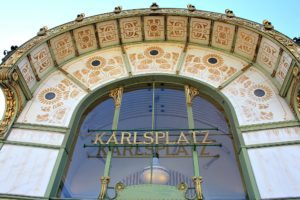 Otto Wagner Vienna. The two identical green, gold and white pavilions at Karlsplatz are a great start to explore Otto Wagner. The pavilions were built in 1898 as station buildings of the Viennese city railway. Today, one of the pavilions houses a documentary about the life and architecture of Wagner, run by Wien Museum. The centrepiece is a model of the architect’s stunning Church at Steinhof. This highlight is also part of the Vienna Art Nouveau History Tour.
Otto Wagner Vienna. The two identical green, gold and white pavilions at Karlsplatz are a great start to explore Otto Wagner. The pavilions were built in 1898 as station buildings of the Viennese city railway. Today, one of the pavilions houses a documentary about the life and architecture of Wagner, run by Wien Museum. The centrepiece is a model of the architect’s stunning Church at Steinhof. This highlight is also part of the Vienna Art Nouveau History Tour.
Location: Karlsplatz, A-1010 Vienna
Timings: April to October; Tuesday to Sunday (and public holidays): 10am to 6pm; closed on 1st May, Easter Monday, Whitmonday and all other public holiday Mondays
Admission: EUR 5 (free admission for children and youth under 19 years of age)
2. Otto Wagner Church
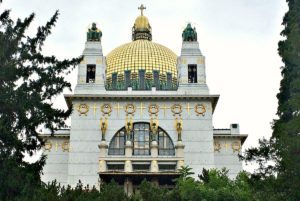 Otto Wagner Vienna. Have you ever been to an Art Nouveau church? The Wagner ‘Kirche Am Steinhof’ was Europe’s first church of the modern era. It is an absolute highlight for fans of Art Nouveau architecture. Walls from white Carrara marble, a dome from gold foil, bronze angel statues, and colourful glass mosaic windows sparked a revolution for clericals and the public. The church was built on the grounds of Vienna’s avantgarde psychiatric clinic for the Mentally Ill.
Otto Wagner Vienna. Have you ever been to an Art Nouveau church? The Wagner ‘Kirche Am Steinhof’ was Europe’s first church of the modern era. It is an absolute highlight for fans of Art Nouveau architecture. Walls from white Carrara marble, a dome from gold foil, bronze angel statues, and colourful glass mosaic windows sparked a revolution for clericals and the public. The church was built on the grounds of Vienna’s avantgarde psychiatric clinic for the Mentally Ill.
The church, along with the hospital, its two dozen pavilions and an Art Nouveau theatre, is the best way to learn about Viennese Jugendstil in all its design perfection. Read tour review.
3. Austrian Postal Savings Bank
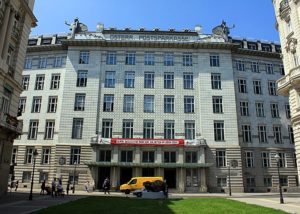 Otto Wagner Vienna. Set amidst stucco-decorated palaces and residential buildings the naked façade of Austrian Postal Savings Bank creates the perfect clash. The public tender for the project was heavily discussed, and Emperor Francis Joseph was reportedly not a friend of Wagner’s utilitarian plan.
Otto Wagner Vienna. Set amidst stucco-decorated palaces and residential buildings the naked façade of Austrian Postal Savings Bank creates the perfect clash. The public tender for the project was heavily discussed, and Emperor Francis Joseph was reportedly not a friend of Wagner’s utilitarian plan.
The Austrian Postal Savings Bank (Postsparkasse) represents a world of modern aesthetics. Everything in this still operating Postal Savings Bank obeys functional beauty: from the aluminium coated iron spikes on the façade to the wooden panels, radiators, clocks, chairs, counters, and door handles. Otto Wagner’s most modern and most important building is a must see for design freaks.
Location: Georg Coch Platz, A-1010 Vienna
Opening Hours WAGNER WERK: Monday to Friday 10.00am to 5.30pm; Big Cash Hall: Monday to Friday 6.00 am to 5.30pm.
Admission: free
4. City Railway Station
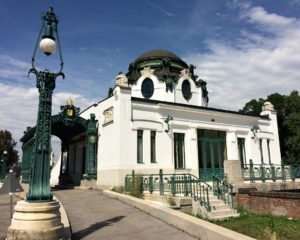 Otto Wagner Vienna. The most beautiful stations designed by Otto Wagner along the U6 are Karlsplatz, Längenfeldgasse, Gumpendorfer Strasse, Währinger Strasse, and Nussdorfer Strasse. The highlights along the U4 are Stadtpark, Schönbrunn, and Hietzing’s Kaiserpavillon (Court Pavillon) at 150 metres distance from the station. The pavilion was built as a private station for Emperor Francis Joseph and boasts precious Art Nouveau interiors. Francis Joseph only used his pavilion twice. The Court Pavilion is part of the Vienna Art Nouveau History Tour.
Otto Wagner Vienna. The most beautiful stations designed by Otto Wagner along the U6 are Karlsplatz, Längenfeldgasse, Gumpendorfer Strasse, Währinger Strasse, and Nussdorfer Strasse. The highlights along the U4 are Stadtpark, Schönbrunn, and Hietzing’s Kaiserpavillon (Court Pavillon) at 150 metres distance from the station. The pavilion was built as a private station for Emperor Francis Joseph and boasts precious Art Nouveau interiors. Francis Joseph only used his pavilion twice. The Court Pavilion is part of the Vienna Art Nouveau History Tour.
Location: Schönbrunner Schlossstrasse (close to Hietzing metro station), A-1130 Vienna
Visits: Saturday and Sunday, 10 am to 1 pm, 2 pm to 6 pm; closed on 1 January, 1 May and 25 December;
Admission: EUR 5
Public Transport: metro U4 or tramway 58 to Hietzing station;
5. Otto Wagner Villa I and II
Wagner Villa and Ernst Fuchs Museum
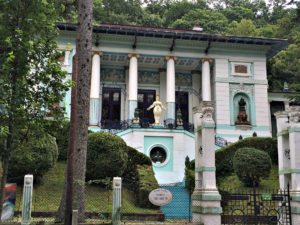 Otto Wagner Vienna. From 1886 to 1888 Wagner built his first villa as a summer residence for himself and his family in a green leafy suburb in the West of Vienna.
Otto Wagner Vienna. From 1886 to 1888 Wagner built his first villa as a summer residence for himself and his family in a green leafy suburb in the West of Vienna.
Today the villa Austrian Fantastic Realism painter Ernst Fuchs owns the villa, using it as his own private museum. Being a fanatic Wagner fan, Fuchs restored many parts of the villa according to Wagner’s initial plans. However, this didn’t prevent him from adding his own flamboyant style to other parts, the interiors and the gardens. Find out more.
Otto Wagner Villa II
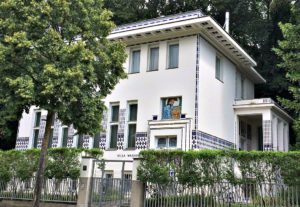 Otto Wagner Vienna. Right next to his mind-blowing first villa, Wagner’s smaller second villa leads a quiet existence. When he designed the house, Wagner wanted a smaller home once his children had left. In those 25 years between the construction of the first and second villa you can clearly see how much Wagner’s artistic style evolved towards Art Nouveau architecture.
Otto Wagner Vienna. Right next to his mind-blowing first villa, Wagner’s smaller second villa leads a quiet existence. When he designed the house, Wagner wanted a smaller home once his children had left. In those 25 years between the construction of the first and second villa you can clearly see how much Wagner’s artistic style evolved towards Art Nouveau architecture.
In brief, the cubistic house consists of modern steel concrete, has narrow high windows and is sparely decorated with blue stripes and ornaments, and aluminium nails. Although villa is privately owned and not open to visitors you can perfectly view the outer design from the street.
6. Residential Buildings
Otto Wagner Vienna. The most popular residential buildings designed by Wagner can be found close to each other at Linke Wienzeile, next to Naschmarkt. Learn more about these buildings during the Vienna Art Nouveau History Tour.
Linke Wienzeile no 38
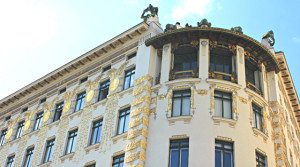 As one of Europe’s prime Art Nouveau jewels, the building no 38 prominently features on a 100 Euro gold coin.
As one of Europe’s prime Art Nouveau jewels, the building no 38 prominently features on a 100 Euro gold coin.
Because it’s one of the biggest eye catchers in the area you will recognise this Wagner building for its great golden ornaments. They cover most of the white façade’s upper part. What’s more, the corner draws a quarter of a circle, what was then ground-breaking solution. As for the golden ornaments they go on Koloman Moser’s account, another great Austrian Art Nouveau artist and painter.
As soon as you spot the building, make sure you zoom in on the fabulous female bronze sculptures on the roof. Today, Linke Wienzeile no 38 houses a branch of an Austrian bank.
Majolikahaus
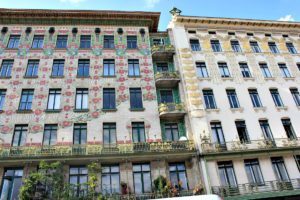 Like many other Wagner fans with a hang for florals my clear favourite Art Nouveau building by Wagner is the Majolikahaus at Linke Wienzeile 40. For Wagner’s style it is unusually colourful and decorative while maintaining a simple shape. Since the facade bursts with glazed red poppy tiles the house acquired the name Majolika. In fact, the name comes from the Spanish tile tradition in Mallorca. However, the greatest draw of these tiles for Otto Wagner less the aesthetics but the fact that they were durable and easy to clean. Can you visit the Majolikahaus? Definitely the second-hand bookshop on the ground floor. The upper floors are privately owned and house residential apartments.
Like many other Wagner fans with a hang for florals my clear favourite Art Nouveau building by Wagner is the Majolikahaus at Linke Wienzeile 40. For Wagner’s style it is unusually colourful and decorative while maintaining a simple shape. Since the facade bursts with glazed red poppy tiles the house acquired the name Majolika. In fact, the name comes from the Spanish tile tradition in Mallorca. However, the greatest draw of these tiles for Otto Wagner less the aesthetics but the fact that they were durable and easy to clean. Can you visit the Majolikahaus? Definitely the second-hand bookshop on the ground floor. The upper floors are privately owned and house residential apartments.
Köstlergasse 3
Just next to no 38, the residential building is the simplest of the three buildings but emanates total elegance. Most notably, at the ground floor and mezzanine the pure white façade with circle shaped and rectangular ornaments and green slim window frames shows grooves. As a matter of fact, Otto Wagner himself lived in the building for a few years. Although located in Linke Wienzeile, the building’s entrance is around Linke Wienzeile at Köstlergasse.
7. Otto Wagner Schützenhaus
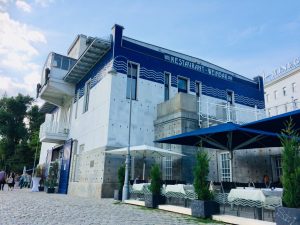 Otto Wagner Vienna. Have you ever seen a more charming barrage? When Vienna regulated the Danube and Danube Canal in the early 20th century, Otto Wagner built this functional building on the left side of the Danube Canal. As beautiful as it is, the Schützenhaus mundanely hosted the movable part of the weir (Schütz). In the end, the weir was never put into operation after the municipality decided not to use a weir in this part of the Canal.
Otto Wagner Vienna. Have you ever seen a more charming barrage? When Vienna regulated the Danube and Danube Canal in the early 20th century, Otto Wagner built this functional building on the left side of the Danube Canal. As beautiful as it is, the Schützenhaus mundanely hosted the movable part of the weir (Schütz). In the end, the weir was never put into operation after the municipality decided not to use a weir in this part of the Canal.
Most notably, cobalt blue wave ornaments flow past the upper part of the stern building. And like at the Postal Savings Bank, Wagner used large nails to accentuate the house’s functional design. If you step into what is now a restaurant (with mediocre reputation) you can still see some original gearwheels and tubes at the ceiling.
Location: Obere Donaustrasse 26, 1020 Vienna (opposite Schottenring metro station)
8. Otto Wagner Vienna: Danube Weir
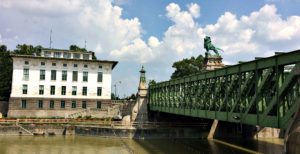 Otto Wagner Vienna. Most locals know Wagner’s Danube Weir at Nussdorf and the Schemerl Bridge (1894 to 1898) from a boat trip on the Western Vienna Danube and Danube Canal. Most spectacularly, the weir boasts two imposing bronze lions on either side. This makes it looks like a city gate, which was the architect’s intention.
Otto Wagner Vienna. Most locals know Wagner’s Danube Weir at Nussdorf and the Schemerl Bridge (1894 to 1898) from a boat trip on the Western Vienna Danube and Danube Canal. Most spectacularly, the weir boasts two imposing bronze lions on either side. This makes it looks like a city gate, which was the architect’s intention.
Other than just marking a city entrance by boat, the weir pinpoints where the Danube Canal bifurcates from the Danube. In the 1960s and 1970s the weir itself underwent thorough renovation. Either way, you can still feel Otto Wagner throughout this brilliant construction when viewing the Schemerl Bridge.
go to Art Nouveau Walk – Map And Route Of Jugendstil Architecture in Wien
find out more about the Vienna 1900 walk – Gustav Klimt And Beyond
visit Gustav Klimt Artwork – Guide To Top Paintings
read my story about the Egon Schiele Museum – The Leopold Collection
go to Vienna Tourism Tips
get back to Vienna Sightseeing Top 10, And Four Extra Tips
back to Vienna Unwrapped homepage
